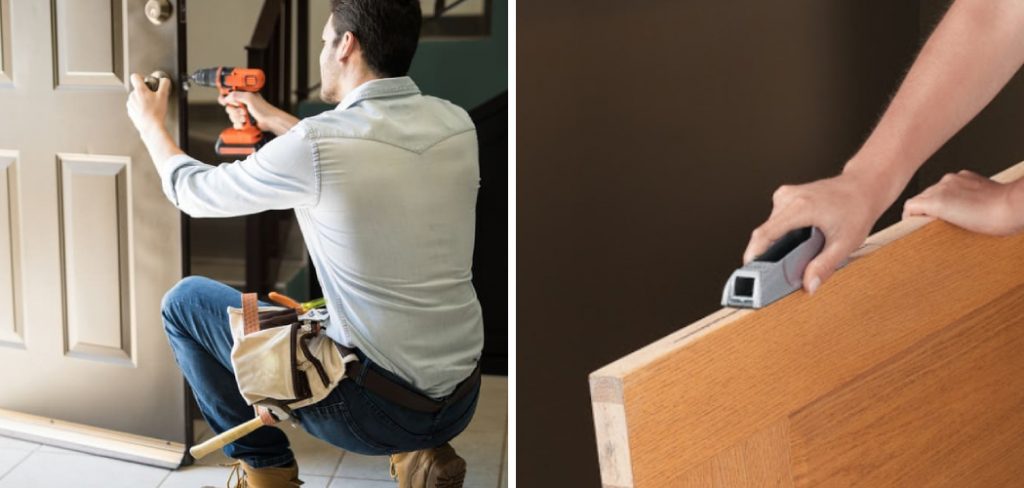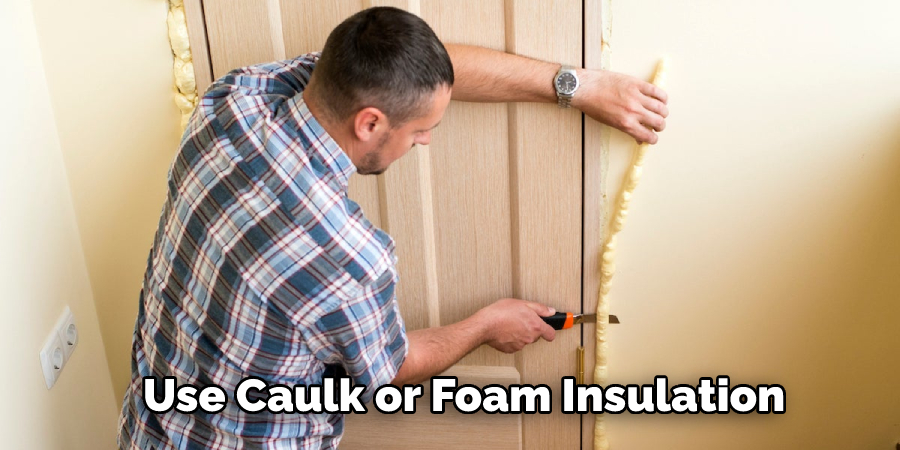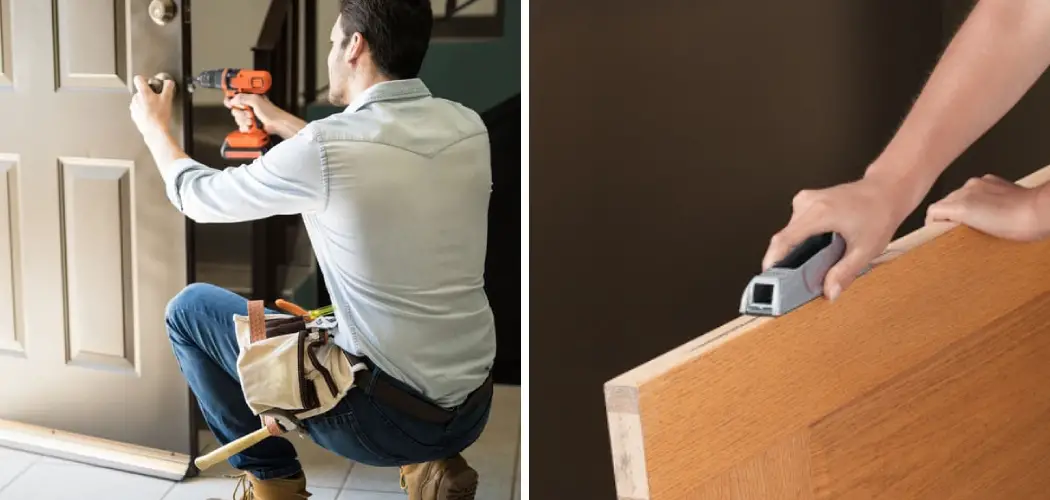Are you dealing with a swollen wood door that seems impossible to open and close? No worries! There are several simple methods to restore your wooden door so that it functions properly. In this blog post, we will cover how to fix swollen wood door. We’ll explain why the swelling occurs and discuss each repair option in detail so you’re well-informed when it’s time to take action. With the right knowledge, tools, and materials at hand, you should have no trouble fixing your problem in no time!

What Causes a Wooden Door to Swell?
When wood absorbs moisture, it swells. This is what causes many wooden doors to become stuck in their frames when the humidity levels rise. Other times, a swollen door is caused by an improper fit, such as mismatched hinges or an incorrectly installed threshold. Improperly hung doors can also cause swelling due to uneven weight distribution. Additionally, if you live in an area with a lot of rain or snow, your door may be at risk for moisture absorption.
10 Methods How to Fix Swollen Wood Door
1. Check the Door for Any Visible Damage
The first step is to check the door for any visible damage. Look for signs of water damage, such as warping or splitting wood, and make sure that the hinges are in good condition. If there is structural damage, you may need to have the door replaced before attempting a repair.
If you see any rust on the hinges or components, they should be replaced as soon as possible to prevent further damage. Make sure that all of the screws are tight and that the strike plate is in its proper place. If you do not feel confident making these repairs on your own, you may want to call a professional.
2. Adjust the Hinges
If your swollen door is caused by an improper fit due to mismatched hinges, you should adjust them accordingly. Loose screws on the hinges can cause them to become misaligned over time, which can lead to a swollen door that’s difficult to open and close. Tighten up any loose screws and make sure they’re aligned correctly with each other so that your door functions properly.
Although it might not seem like a big deal, an improperly fitted door can be dangerous and lead to serious injury. Always use the correct tools when adjusting your hinges to ensure your safety.

3. Replace the Threshold
If the threshold of your door isn’t installed properly, it can cause a swollen door that’s difficult to open and close. Check to see if the threshold is level with the floor and replace it if necessary. This will not only help your door function better, but it will also prevent any future swelling due to moisture absorption. If you do decide to replace the threshold, make sure you purchase one that is made of a material that won’t absorb moisture as easily. This will help keep your door from swelling in the future.
4. Check That The Door is Evenly Hung
Uneven weight distribution can lead to a swollen wood door, so make sure that the door is hung evenly on each side of the frame. If one side seems heavier than the other, adjust accordingly until both sides are in balance and secure with screws or nails. However, if the door is too warped to hang evenly, you may need to replace it. Make sure to check the door’s warranty to see if it is covered.
5. Check the Weatherstripping
If your door has weatherstripping, inspect it for any visible damage or gaps that could be allowing moisture in. Replace any worn-out strips and make sure all the seams are tight so moisture won’t seep into the frame and cause swelling. Though weatherstripping is an inexpensive way to insulate a door, it’s not always the best option. If your weatherstripping has failed, consider investing in a door sweep or other sealant to form a better barrier against moisture. Try to avoid using silicone sealants, as they can degrade over time and become ineffective.

6. Install a Storm Door
A storm door can help protect your wood door from water damage caused by rain or snow. Installing a storm door will also provide an extra layer of insulation to keep humidity levels low, which can prevent swelling in the future. While a storm door may cost more upfront, it can help save you money in the long run by preventing damage to your wood door. The installation process is fairly straightforward and should be completed by a professional.
Start by measuring the width and height of your doorway to ensure the storm door will fit properly. Next, attach the frame to the door jamb with screws and make sure it is level. Finally, install the storm door with hinges and secure it with screws. Make sure all hardware is tight and secure before testing the door for proper operation.
7. Use a Dehumidifier
Using a dehumidifier in areas with high humidity can help reduce the amount of moisture in the air and keep your door from swelling. Place a dehumidifier in the room where the door is located, or invest in a whole-house system to reduce humidity levels throughout your home. If you’re using a portable dehumidifier, you should empty it regularly to make sure the air is being properly circulated, and humidity is kept to a minimum.
Keeping the humidity in your home at an optimal level will help prevent swelling and warping of all wood furniture and doors, not just the ones that are causing problems. If you’re not sure what the optimal humidity level is in your home, invest in a hygrometer to measure it. Doing so will help you maintain the correct humidity level throughout your home and prevent problems like swelling doors from occurring in the future.
8. Seal The Doorframe
Sealing the frame of your wood door can help prevent moisture from entering and causing swelling. Apply an exterior-grade sealant to any cracks or seams around the frame and seal it with painter’s tape for best results. This will create a barrier that will block out rain and snow while also helping to insulate your home against energy loss.
If you find any gaps between the door and frame, use caulk or foam insulation to fill them in. This is especially important if you live in an area that experiences extreme temperatures. Sealing the doorframe will also help prevent drafts and keep your home comfortable year-round.

9. Use a Hair Dryer
If your wooden door has already swollen due to moisture absorption, you can use a hair dryer to try and shrink it back down. This method is best used in moderation since it could cause damage to the wood if done too aggressively. Place the hairdryer on its lowest setting and aim it at the edges of the door until they start to shrink back down. However, it is important to regularly check the temperature of the wood with your hand as you don’t want to over-dry it. Once it reaches its original size, stop using the hair dryer and put a dehumidifier in the room to reduce the moisture levels.
10. Replace The Door
If all else fails, your last resort may be to replace the swollen wooden door with a new one. Measure your existing door before purchasing a replacement so you get the correct size, and check for any pre-made kits that come with all necessary hardware for installation. With these steps, you should be able to fix your swelling door problem and get it functioning properly again.
Things to Consider When Fixing Swollen Wood Door
1. Identify the Source of the Swelling:
Look for any moisture that has caused the wood to swell, such as water leaking from a broken pipe or a damp basement.
2. Use a Dehumidifier:
Using a dehumidifier will help to reduce the humidity in your home and prevent further swelling of the door.

3. Adjust the Humidity Levels:
Adjusting your thermostat to maintain an ideal indoor humidity level of 40-50% can help keep your doors from swelling again.
4. Replace Weather Stripping and Thresholds:
Replace any worn-out weather stripping or thresholds that may be allowing moisture into the area where the door is located.
5. Sand Down Swollen Areas:
Sand down any swollen areas of the wood, then apply a sealant to protect the door from moisture.
Conclusion
If your wood door is swollen, there are a few things you can do to fix it. First, check the door for leaks. If there are no leaks, then you can try sanding down the door. Swollen wood doors are a common problem, but there are a few things you can do to fix them.
If the door is still usable, sanding and staining or painting the door will help to protect it from further damage.
You can also use a humidifier in your home to help control the level of humidity and prevent the door from swelling again in the future. Thanks for reading our blog post on how to fix swollen wood door! We hope you found it helpful and informative.
You Can Check It Out to Fill Hinge Holes in Door Frame

